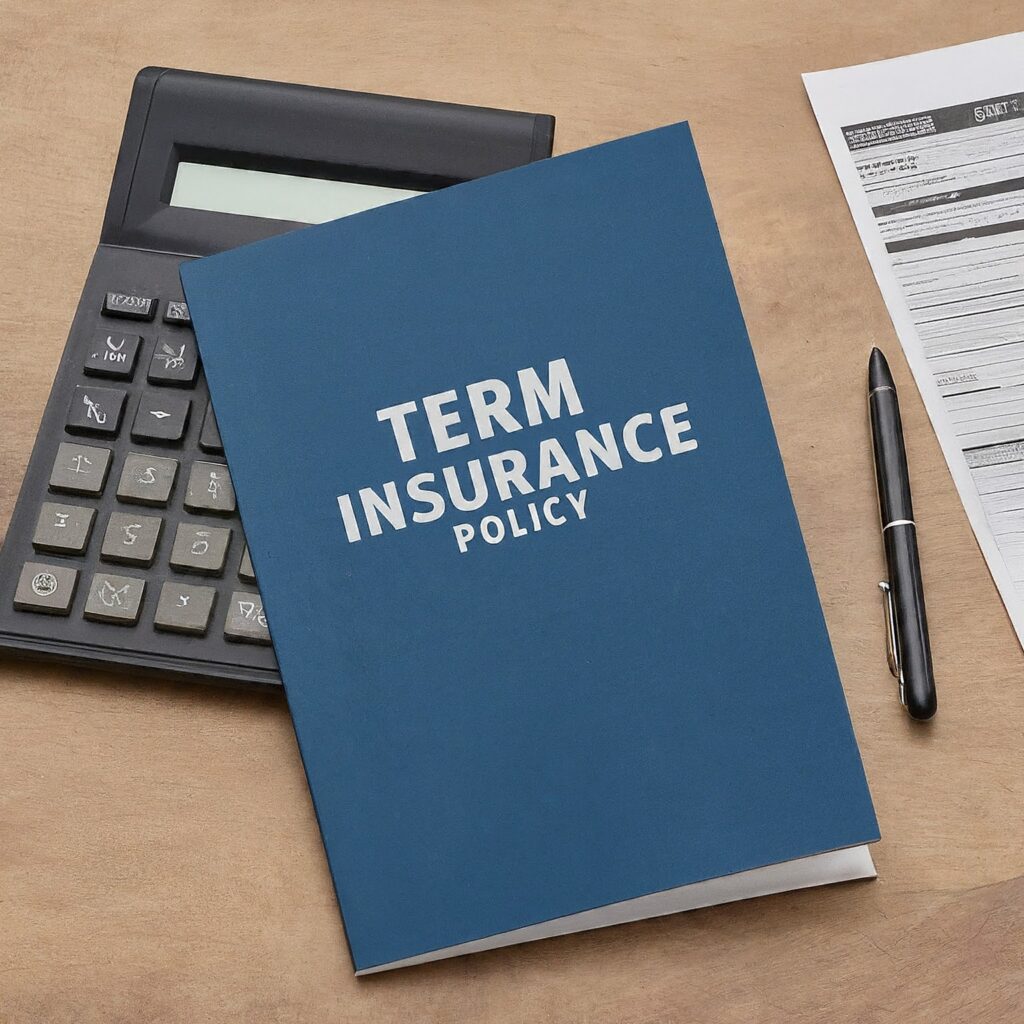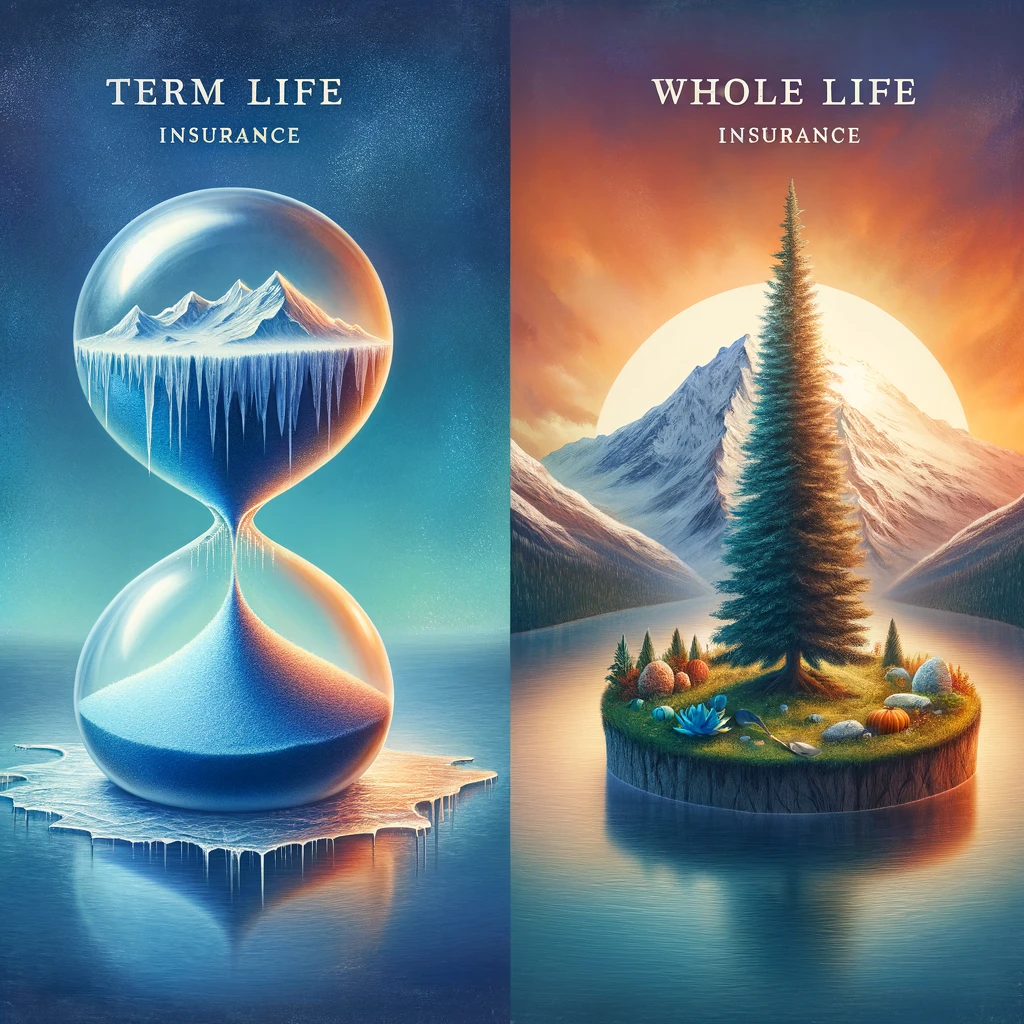Choosing between Term and Whole Life Insurance is a significant decision that can impact your financial planning and the financial security of your family. This blog aims to elucidate the primary differences between these two popular types of life insurance, helping you decide which suits your needs best.

Understanding of Term Life Insurance
Term life insurance is a straightforward form of life insurance that provides coverage for a specific time period, or “term.” It’s designed to offer a financial safety net during years you might consider most vulnerable, such as when raising children or paying off a mortgage.
- Affordability: Term life insurance is typically less expensive than whole life insurance because it does not build cash value and only provides a death benefit.
- Flexibility: You can choose the term length that best fits your needs, commonly 10, 20, or 30 years.
- Temporary Coverage: It’s important to note that term life insurance does not offer lifelong coverage and has no investment component.
Understanding Whole Life Insurance
Whole life insurance, by contrast, provides lifelong coverage and includes an investment component known as cash value. This type of insurance is designed to last for your entire life, offering both a death benefit and cash value accumulation.
- Lifelong Protection: Coverage that lasts for your entire life, as long as premiums are paid.
- Cash Value: A portion of your premium goes toward building cash value, which can grow at a guaranteed rate and be borrowed against if needed.
- Higher Premiums: Whole life insurance premiums are higher because they fund the cash value account in addition to providing insurance.

Key Differences Between Term and Whole Life Insurance
Term and Whole Life Insurance The most significant difference lies in duration and cash value accumulation. Term life is temporary and less expensive, making it a good choice for short-term needs. Whole life, however, provides permanent coverage and accumulates cash value, making it suitable for those looking for a combined investment and insurance product.
- Cost Comparison: Term insurance is generally cheaper but does not build equity, whereas whole life is more expensive but part of your premium builds cash value.
- Financial Planning: Whole life insurance can be part of your financial strategy, offering the ability to borrow against the policy’s cash value and potentially receiving dividends.
What is Term Life Insurance?
Term life insurance is designed to provide financial protection for a specific period, such as 10, 20, or 30 years. It’s suitable for those seeking a straightforward, temporary life insurance solution.
Pros of Term Life Insurance:
- Cost-Effective: Generally offers more coverage for lower premiums, making it affordable for most individuals.
- Simplicity: Straightforward insurance coverage without an investment component.
- Flexibility: You can choose the term that best suits your coverage needs.
Cons of Term Life Insurance:
- Temporary Coverage: Once the term expires, so does the coverage unless you renew it, often at higher rates.
- No Equity: Unlike whole life, there is no cash value accumulation, so you can’t borrow against the policy or receive any financial value if the term ends and you’re still living.

What is Whole Life Insurance?
Whole life insurance provides lifelong coverage with the additional benefit of accumulating cash value. It’s a type of permanent life insurance that includes an investment component.
Pros of Whole Life Insurance:
- Lifelong Coverage: Coverage that doesn’t expire as long as premiums are paid.
- Cash Value: Part of each premium goes toward building cash value, which can be used later in life or borrowed against.
- Fixed Premiums: Premiums generally remain the same throughout the policy’s duration, making budgeting easier.
Cons of Whole Life Insurance:
- Higher Cost: Premiums are significantly higher than term life insurance.
- Complexity: The inclusion of cash value and other features make it more complex than term life.
- Inflexibility: Higher premiums mean less flexibility in adjusting your financial planning due to budget constraints.
Benefits and Drawback of Term and Whole life Insurance

Term Life Insurance:
Benefits:
- Affordability: Premiums are generally lower, making it easier to buy higher coverage at a lower cost.
- Simplicity: Straightforward and easy to understand, offering pure death benefit protection without an investment component.
- Flexibility: You can choose the term that best suits your needs (e.g., 10, 20, 30 years), which can align with specific financial obligations like a mortgage or education expenses.
Drawbacks
- Temporary Coverage: Only provides coverage for a set period, after which the policy expires without value if the insured survives the term.
- Increasing Costs: Renewing the policy after it expires can be costly, especially as the insured ages or if their health has declined.
- No Cash Value: Does not accumulate any cash value that can be used or borrowed against.
Whole Life Insurance:
Benefits:
- Lifetime Coverage: As long as premiums are paid, coverage lasts for the insured’s entire life, providing long-term peace of mind.
- Cash Value Accumulation: Part of the premium builds cash value, which can grow tax-deferred over time and can be borrowed against.
Drawbacks
- Higher Cost: Premiums are significantly higher than term life insurance, which might make it less affordable for some.
- Complexity: Involves elements like cash value, dividends (in some cases), and other features that can make the policy more complicated to manage and understand.
- Less Flexibility: The higher premiums may commit you to a long-term financial obligation that might not be as easily adjusted as your financial situation changes.

Which is Better ? Term and whole life Insurance
| Feature | Term Life Insurance | Whole Life Insurance |
| Coverage Duration | Fixed period (e.g., 10, 20, 30 years) | Lifetime coverage |
| Cost | Generally lower premiums | Higher premiums |
| Cash Value | No cash value accumulation | Builds cash value over time |
| Purpose | Ideal for temporary needs, such as debt repayment or child-rearing years | Suited for long-term financial planning, providing both death benefit and a savings component |
| Flexibility | Premiums and coverage end after the term expires | Permanent coverage with potential to borrow against the cash value |
| Investment Component | None | Cash value can be invested and may earn interest |
| Premium Stability | Premiums typically stay the same during the term | Premiums are generally fixed and do not increase as you age |
Choosing the Right Type of Insurance –Term and whole life Insurance
Deciding whether Term and whole life Insurance is right for you depends on your individual financial situation and long-term goals.
- Consider Term Life If: You need coverage for a specific period, such as until your children graduate from college or a mortgage is paid off.
- Consider Whole Life If: You are looking for a product that offers both a death benefit and an opportunity to accumulate cash value for long-term financial planning.
What happens to term life insurance at the end of the term?
At the end of a term life insurance policy, the coverage typically expires without any payout if the insured has not passed away during the term. The policyholder may have several options, such as renewing the po e policy into a whole life or permanent insurance policy, or simply letting the coverage end. Term and whole life Insurance depends on the terms set by the insurance provider and the specific policy agreements.
The Bottom line
Term and whole life Insurance offer different benefits, catering to specific needs. Term life insurance is cost-effective and straightforward, ideal for temporary coverage needs, while whole life insurance offers a combination of death benefit protection and a savings component, suited for those looking for a long-term investment. Understanding the pros and cons of Term and whole life Insurance can guide you to the policy that best aligns with your financial goals and provides the desired security for your circumstances.
FAQs
Can I convert term life to whole life insurance?
Yes, many term life policies offer a conversion rider that allows you to convert your policy to whole life insurance without a medical exam, albeit at higher premiums.
What happens to the cash value in whole life insurance when I die?
The cash value is generally absorbed by the insurance company, and your beneficiaries receive the death benefit. Some policies may offer an increased death benefit that includes the cash value.
Is whole life insurance a good investment?
While whole life insurance does provide an investment component, it’s generally not as efficient as other investment vehicles due to the costs of the insurance. It should be considered a part of a broader financial strategy.
When it comes to cost, how do term and whole life insurance differ?
Term life insurance premiums are generally lower than whole life insurance premiums because term life does not build cash value and only offers death benefit protection.
You might be interested in reading related https://moneyymagnett.com/best-finance-books-for-women/

